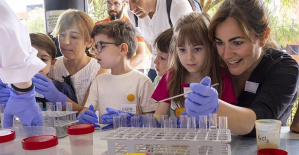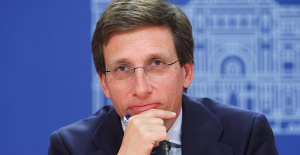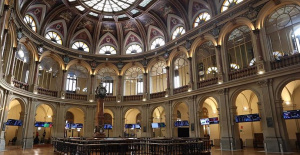Household spending registers its first quarterly decline in a year, while year-on-year GDP accelerates its advance to 6.3%
The Spanish economy slowed its quarterly growth two points between January and March, to 0.2%, one tenth less than expected, due to the slowdown experienced by household consumption, according to National Accounts data published this Friday by the National Statistics Institute (INE).
In contrast, the year-on-year growth of GDP accelerated eight tenths in the first quarter, from 5.5% in the last quarter of 2021 to 6.3%. However, this rate is one tenth lower than that advanced by Statistics in April.
The acceleration in year-on-year GDP growth is due to the greater contribution from the foreign sector and, to a lesser extent, from domestic demand. Specifically, external demand contributed 2.3 points to year-on-year GDP in the first quarter, a figure five tenths higher than that of the previous quarter and its highest contribution in nine years, while national demand contributed 4 points, two tenths more.
Statistics explained that the advance data for the first quarter was made based on statistical indicators that offered results up to February (the war in Ukraine began almost at the end of that month), while the results published this Friday already cover "in the immense most cases", the quarter as a whole.
At the end of April, the data advanced by the INE for the first quarter pointed to a quarterly GDP growth of 0.3% and an interannual rate of 6.4%, rates, in both cases, that exceeded those published by one tenth this Friday.
The agency estimates that household consumption contracted by 2% in the first quarter, compared to the 1.5% growth registered in the last quarter of 2021. It is the first negative rate of family spending since the first quarter of 2021, when it contracted 2.6%. However, this decline has moderated compared to the estimate at the end of April, when a drop in household consumption of 3.7% was anticipated, the largest since confinement.
Faced with this evolution, public spending returned to positive rates in the first quarter, although it hardly grew: only 0.1% between January and March, compared to the drop of 1.6% in the previous quarter. Spending by non-profit institutions also returned to positive rates after growing 2% between January and March after three quarters of falls.
Investment, for its part, accelerated its quarterly advance three tenths, to 3.4%, its highest rise since the third quarter of 2020, thanks to the boost from investment in machinery and capital goods (9.1%) and to a lesser extent, in housing (0.4%).
Regarding the foreign sector, exports slowed their quarterly growth to 1.1%, compared to the previous 7.2%, while imports fell by 0.8%, their first drop in a quarter since confinement.
Employment in the economy, in terms of hours worked, grew by 3.2% in the quarter, which is 3.3 points more than in the previous quarter. This rate is smaller in the case of full-time equivalent jobs (0.5%, two tenths less than in the previous quarter) due to the increase in average full-time working hours (2.6%).
YEAR-ON-YEAR GDP ACCELERATES TO 6.3%, WITH PUBLIC EXPENDITURE IN NEGATIVE
Despite the quarterly moderation in GDP, the year-on-year growth of the Spanish economy accelerated by eight tenths in the first quarter, from 5.5% in the last quarter of 2021 to 6.3%, thanks both to the greater increase in consumption by families as to investment.
Thus, household consumption accelerated its year-on-year growth seven tenths in the first quarter, to 4.9%, in contrast to public spending, which fell by 0.4%, its first year-on-year decrease since the fourth quarter of 2014 .
For its part, like family consumption, investment also stepped up the accelerator and rose by 6.8% year-on-year in the first quarter, four points more than in the previous quarter.
By economic sectors, services led year-on-year growth, with an increase in gross value added of 8.4%, followed by industry, with a rise of 0.9%, and construction (0.7%). On the other hand, agriculture registered a decrease of 2.3%.
With regard to the foreign sector, exports accelerated their year-on-year growth two tenths, to 18.1%, while imports moderated their growth rate by more than one point, from 13.1% in the fourth quarter of 2021 to 11.7% in the first quarter of this year.
At current prices, GDP for the first quarter stood at 317,928 million euros, 1,587 million euros less than in the previous quarter, but almost 30,000 million more than in the first quarter of 2021, which represents a year-on-year advance of 10, 4%, three tenths more than in the previous quarter.
With this, the implicit deflator of the economy presented a year-on-year variation of 3.9%, four tenths less than in the previous quarter.
EMPLOYMENT MODERATES ITS ANNUAL PROGRESS RATE
Employment, measured in terms of National Accounts, grew by 5.3% year-on-year in the first quarter, five tenths less than in the previous quarter, which represents an increase of 934,000 full-time equivalent jobs in one year.
In year-on-year terms, the hours actually worked rose by 7.5% in the first quarter, a rate 4.8 points higher than that of the same period in 2021.
Productivity per full-time equivalent job recorded a year-on-year increase of 1% (-0.3% in the previous quarter), its biggest advance in eight years, while apparent productivity per hour actually worked fell by 1.1 %, compared to the year-on-year increase of 2.8% in the previous quarter.
The labor cost per unit of product (CLU) fell by 0.2% year-on-year in the first quarter, a rate 4.1 points lower than the variation experienced by the implicit deflator of the economy (3.9%).
For its part, the remuneration of employees increased by 7% year-on-year in the first quarter, 1.2 points more than in the previous quarter, after increasing the number of employees by 6.2%, four tenths more, and raising the average compensation per employee by 0.8%, compared to the stagnation experienced in the fourth quarter of 2021. At the same time, the gross operating surplus grew by 12% year-on-year, 2.7 points less than in the previous quarter.

 Exploring Cardano: Inner Workings and Advantages of this Cryptocurrency
Exploring Cardano: Inner Workings and Advantages of this Cryptocurrency Seville.- Economy.- Innova.- STSA inaugurates its new painting and sealing hangar in San Pablo, for 18 million
Seville.- Economy.- Innova.- STSA inaugurates its new painting and sealing hangar in San Pablo, for 18 million Innova.- More than 300 volunteers join the Andalucía Compromiso Digital network in one month to facilitate access to ICT
Innova.- More than 300 volunteers join the Andalucía Compromiso Digital network in one month to facilitate access to ICT Innova.-AMP.- Ayesa acquires 51% of Sadiel, which will create new technological engineering products and expand markets
Innova.-AMP.- Ayesa acquires 51% of Sadiel, which will create new technological engineering products and expand markets Vox brings together Milei, Le Pen and other figures from its space this weekend in Madrid as the starting signal for 9J
Vox brings together Milei, Le Pen and other figures from its space this weekend in Madrid as the starting signal for 9J The cargo ship Borkum suspends its stopover in Cartagena and heads to Slovenia
The cargo ship Borkum suspends its stopover in Cartagena and heads to Slovenia French Police kill an armed man who tried to set fire to a synagogue in Rouen
French Police kill an armed man who tried to set fire to a synagogue in Rouen FCC will bring to its board the distribution of a flexible dividend of 283 million and its partial spin-off
FCC will bring to its board the distribution of a flexible dividend of 283 million and its partial spin-off How Blockchain in being used to shape the future
How Blockchain in being used to shape the future Not just BTC and ETH: Here Are Some More Interesting Coins Worth Focusing on
Not just BTC and ETH: Here Are Some More Interesting Coins Worth Focusing on The Valencian researcher José Rafael Penadés, named 'fellow' of the British Royal Society
The Valencian researcher José Rafael Penadés, named 'fellow' of the British Royal Society UPV researchers bring their new method to achieve ultra-resistant buildings to the cover of 'Nature'
UPV researchers bring their new method to achieve ultra-resistant buildings to the cover of 'Nature' The CSN finances an IFIC project to evaluate a technology that improves nuclear waste management
The CSN finances an IFIC project to evaluate a technology that improves nuclear waste management Expociència expects to receive more than 4,000 visitors in the Science Park of the University of Valencia
Expociència expects to receive more than 4,000 visitors in the Science Park of the University of Valencia A million people demonstrate in France against Macron's pension reform
A million people demonstrate in France against Macron's pension reform Russia launches several missiles against "critical infrastructure" in the city of Zaporizhia
Russia launches several missiles against "critical infrastructure" in the city of Zaporizhia A "procession" remembers the dead of the Calabria shipwreck as bodies continue to wash up on the shore
A "procession" remembers the dead of the Calabria shipwreck as bodies continue to wash up on the shore Prison sentences handed down for three prominent Hong Kong pro-democracy activists
Prison sentences handed down for three prominent Hong Kong pro-democracy activists ETH continues to leave trading platforms, Ethereum balance on exchanges lowest in 3 years
ETH continues to leave trading platforms, Ethereum balance on exchanges lowest in 3 years Investors invest $450 million in Consensys, Ethereum incubator now valued at $7 billion
Investors invest $450 million in Consensys, Ethereum incubator now valued at $7 billion Alchemy Integrates Ethereum L2 Product Starknet to Enhance Web3 Scalability at a Price 100x Lower Than L1 Fees
Alchemy Integrates Ethereum L2 Product Starknet to Enhance Web3 Scalability at a Price 100x Lower Than L1 Fees Mining Report: Bitcoin's Electricity Consumption Declines by 25% in Q1 2022
Mining Report: Bitcoin's Electricity Consumption Declines by 25% in Q1 2022 Oil-to-Bitcoin Mining Firm Crusoe Energy Systems Raised $505 Million
Oil-to-Bitcoin Mining Firm Crusoe Energy Systems Raised $505 Million Microbt reveals the latest Bitcoin mining rigs -- Machines produce up to 126 TH/s with custom 5nm chip design
Microbt reveals the latest Bitcoin mining rigs -- Machines produce up to 126 TH/s with custom 5nm chip design Bitcoin's Mining Difficulty Hits a Lifetime High, With More Than 90% of BTC Supply Issued
Bitcoin's Mining Difficulty Hits a Lifetime High, With More Than 90% of BTC Supply Issued The Biggest Movers are Near, EOS, and RUNE during Friday's Selloff
The Biggest Movers are Near, EOS, and RUNE during Friday's Selloff Global Markets Spooked by a Hawkish Fed and Covid, Stocks and Crypto Gain After Musk Buys Twitter
Global Markets Spooked by a Hawkish Fed and Covid, Stocks and Crypto Gain After Musk Buys Twitter Bitso to offset carbon emissions from the Trading Platform's ERC20, ETH, and BTC Transactions
Bitso to offset carbon emissions from the Trading Platform's ERC20, ETH, and BTC Transactions Draftkings Announces 2022 College Hoops NFT Selection for March Madness
Draftkings Announces 2022 College Hoops NFT Selection for March Madness



























